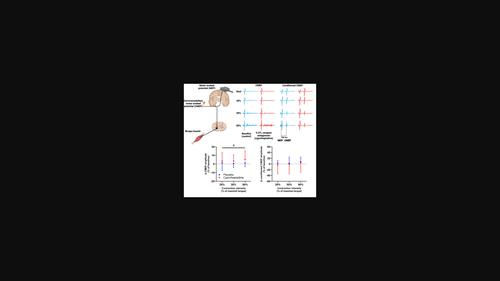当前位置:
X-MOL 学术
›
Eur. J. Neurosci.
›
论文详情
Our official English website, www.x-mol.net, welcomes your feedback! (Note: you will need to create a separate account there.)
Excitatory drive to spinal motoneurones is necessary for serotonin to modulate motoneurone excitability via 5-HT2 receptors in humans
European Journal of Neuroscience ( IF 3.698 ) Pub Date : 2023-11-22 , DOI: 10.1111/ejn.16190 Tyler T. Henderson 1 , Janet L. Taylor 2, 3 , Jacob R. Thorstensen 4 , Justin J. Kavanagh 1
European Journal of Neuroscience ( IF 3.698 ) Pub Date : 2023-11-22 , DOI: 10.1111/ejn.16190 Tyler T. Henderson 1 , Janet L. Taylor 2, 3 , Jacob R. Thorstensen 4 , Justin J. Kavanagh 1
Affiliation

|
Serotonin modulates corticospinal excitability, motoneurone firing rates and contractile strength via 5-HT2 receptors. However, the effects of these receptors on cortical and motoneurone excitability during voluntary contractions have not been explored in humans. Therefore, the purpose of this study was to investigate how 5-HT2 antagonism affects corticospinal and motoneuronal excitability with and without descending drive to motoneurones. Twelve individuals (aged 24 ± 4 years) participated in a double-blind, placebo-controlled, crossover study, whereby the 5-HT2 antagonist cyproheptadine was administered. Transcranial magnetic stimulation (TMS) was delivered to the motor cortex to produce motor evoked potentials (MEPs), and electrical stimulation at the cervicomedullary junction was used to generate cervicomedullary motor evoked potentials (CMEPs) in the biceps brachii at rest and during a range of submaximal elbow flexions. Evoked potentials were also obtained after a conditioning TMS pulse to produce conditioned MEPs and CMEPs (100 ms inter-stimulus interval). 5-HT2 antagonism reduced maximal torque (p < 0.001), and compared to placebo, reduced unconditioned MEP amplitude at rest (p = 0.003), conditioned MEP amplitude at rest (p = 0.033) and conditioned MEP amplitude during contractions (p = 0.020). 5-HT2 antagonism also increased unconditioned CMEP amplitude during voluntary contractions (p = 0.041) but not at rest. Although 5-HT2 antagonism increased long-interval intracortical inhibition, net corticospinal excitability was unaffected during voluntary contractions. Given that spinal motoneurone excitability was only affected when descending drive to motoneurones was present, the current study indicates that excitatory drive is necessary for 5-HT2 receptors to regulate motoneurone excitability but not intracortical circuits.
中文翻译:

脊髓运动神经元的兴奋性驱动是血清素通过 5-HT2 受体调节人体运动神经元兴奋性所必需的
血清素通过 5-HT 2受体调节皮质脊髓兴奋性、运动神经元放电率和收缩强度。然而,这些受体对自主收缩期间皮质和运动神经元兴奋性的影响尚未在人类中进行探索。因此,本研究的目的是研究5-HT 2拮抗作用如何影响皮质脊髓和运动神经元的兴奋性,无论是否有运动神经元的驱动力下降。12 名个体(年龄 24 ± 4 岁)参加了一项双盲、安慰剂对照、交叉研究,其中使用了5-HT 2拮抗剂赛庚啶。经颅磁刺激(TMS)被传递到运动皮层以产生运动诱发电位(MEP),颈髓交界处的电刺激用于在休息时和一系列活动期间在肱二头肌中产生颈髓运动诱发电位(CMEP)。肘部次最大屈曲。在调节 TMS 脉冲产生调节 MEP 和 CMEP(100 ms 刺激间间隔)后也获得了诱发电位。5-HT 2拮抗作用降低了最大扭矩 ( p < 0.001),并且与安慰剂相比,降低了静息时的无条件 MEP 振幅 ( p = 0.003)、静息时的条件 MEP 振幅 ( p = 0.033) 和收缩期间的条件 MEP 振幅 ( p = 0.020)。5-HT 2拮抗作用还会增加随意收缩期间的无条件 CMEP 振幅 ( p = 0.041),但在休息时不会增加。尽管5-HT 2拮抗作用增加了长间隔皮质内抑制,但在随意收缩期间净皮质脊髓兴奋性不受影响。鉴于脊髓运动神经元兴奋性仅在存在运动神经元下行驱动时才受到影响,目前的研究表明,兴奋性驱动对于 5-HT 2受体调节运动神经元兴奋性是必要的,但不是皮质内回路。
更新日期:2023-11-22
中文翻译:

脊髓运动神经元的兴奋性驱动是血清素通过 5-HT2 受体调节人体运动神经元兴奋性所必需的
血清素通过 5-HT 2受体调节皮质脊髓兴奋性、运动神经元放电率和收缩强度。然而,这些受体对自主收缩期间皮质和运动神经元兴奋性的影响尚未在人类中进行探索。因此,本研究的目的是研究5-HT 2拮抗作用如何影响皮质脊髓和运动神经元的兴奋性,无论是否有运动神经元的驱动力下降。12 名个体(年龄 24 ± 4 岁)参加了一项双盲、安慰剂对照、交叉研究,其中使用了5-HT 2拮抗剂赛庚啶。经颅磁刺激(TMS)被传递到运动皮层以产生运动诱发电位(MEP),颈髓交界处的电刺激用于在休息时和一系列活动期间在肱二头肌中产生颈髓运动诱发电位(CMEP)。肘部次最大屈曲。在调节 TMS 脉冲产生调节 MEP 和 CMEP(100 ms 刺激间间隔)后也获得了诱发电位。5-HT 2拮抗作用降低了最大扭矩 ( p < 0.001),并且与安慰剂相比,降低了静息时的无条件 MEP 振幅 ( p = 0.003)、静息时的条件 MEP 振幅 ( p = 0.033) 和收缩期间的条件 MEP 振幅 ( p = 0.020)。5-HT 2拮抗作用还会增加随意收缩期间的无条件 CMEP 振幅 ( p = 0.041),但在休息时不会增加。尽管5-HT 2拮抗作用增加了长间隔皮质内抑制,但在随意收缩期间净皮质脊髓兴奋性不受影响。鉴于脊髓运动神经元兴奋性仅在存在运动神经元下行驱动时才受到影响,目前的研究表明,兴奋性驱动对于 5-HT 2受体调节运动神经元兴奋性是必要的,但不是皮质内回路。



























 京公网安备 11010802027423号
京公网安备 11010802027423号